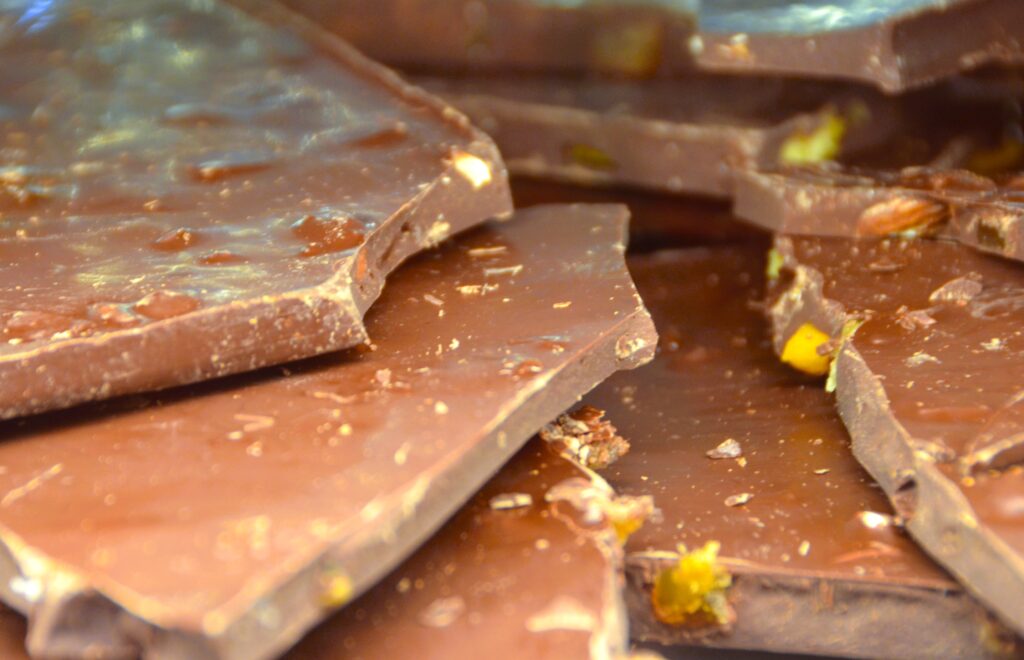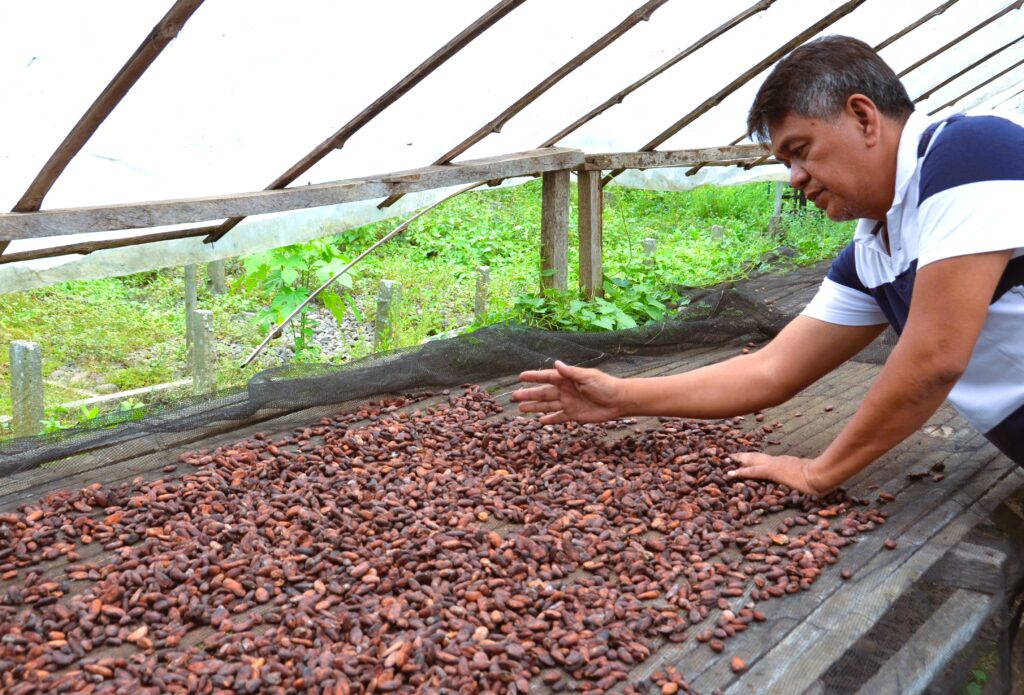Text and Photos by Henrylito D. Tacio
The world is full of chocolics – or those people who love chocolates. Jennifer Garner has publicly professed her love for chocolate many times. Oprah Winfrey has shared her love for chocolate on her talk show and in interviews. Rihanna has partnered with a chocolate company to create her own line of chocolates. Kate Middleton has also created her own chocolate dessert with a Michelin-starred chef during a royal engagement.
Among the male celebrities, a huge fan of chocolates is Hugh Jackman. He has been spotted carrying bags of chocolate on occasion and has even confessed to sneaking treats on movie sets. Other chocoholics are Kofi Siriboe, Dwyane Wade, Lance Gross, Kevin Hart and Idris Elba.
What most people – particularly those in the United States and other industrialized countries – don’t know is that chocolates is made from cacao beans – or rather seeds – from the Theobroma cacao tree, whose scientific name means “food of the gods” in Greek.
Where cacao is mainly grown
Cacao is native to the Amazon rainforest. It was first domesticated at least 5,300 years ago by the Mayo-Chinchipe culture in South America. Cacao was then introduced and widely cultivated in Mesoamerica by the Maya, Toltec, and Aztec peoples. These people used cacao beans to make a beverage, sometimes for ceremonies, and as a currency.
According to agricultural experts, cacao grows exclusively in the cacao belt, an area of land around the equator between 20 degrees latitude north and south. The trees grow within 10 degrees of the equator.
By the way, some experts use “cacao” for the pods, beans and ground-up contents of the beans, reserving “cocoa” for the powder left after pressing the fat out of the ground beans
Makers of raw (unroasted) or less processed cacao bean products often use the word cacao rather than cocoa, which may imply that they’re more natural products.
Bean-to-bar chocolatiers, who make chocolate from scratch starting with fermented, dried beans, only use the word cacao for the pods and beans before they’re fermented. After fermentation, they call them cocoa beans.
Cacao was introduced to the Philippines in the 17th century through the Spanish Galleon Trade, which connected Mexico, the Philippines, and Spain. It was Spanish mariner Pedro Bravo de Lagunas, who first planted cacao in San Jose, Batangas, thus making the country the first in Asia to cultivate the crop.
Cacao production in the country
The Philippines is located in the cacao goldilocks zone. But aside from geographic location, there are several critical factors that should be met to grow cacao successfully. These are the right climate conditions (temperature, rainfall, humidity, light, and shade), the right soil conditions, and the right topography.
Fortunately, the Philippines checks all those criteria. That’s why the country grows all three major types of cacao varieties: Criollo (prized for its rarity), Forestero (the backbone of cacao production globally), and Trinitario (a hybrid of Criollo and Forestero).
In the 1950s, commercial cacao farms were established and cocoa beans production expanded into an industry in the following decade as processing facilities were put up by a group of Filipino investors. The industry started to take-off in the mid-1980s as more investments were poured on commercial farms and on grinding facilities.
However, the growth of the industry ceased when the Comprehensive Agrarian Reform Program (CARP) took effect in 1988, which resulted in the breakdown and redistribution of the commercial farms into small farm units. In addition, the outbreak of the cocoa pod borer pest was unchecked causing some plantations to be wiped out and abandoned.
These factors resulted in the degradation of the cacao regions and a serious decline in the cacao industry.
But in recent years, cacao growing is making a comeback. This is due to the intense demand for chocolates around the world. In fact, chocolate consumption worldwide has been growing at 3% percent annually, recent studies have shown.
“Though the majority of cacao is consumed in North America and Europe, demand is growing more rapidly in Asia where strong economic growth, particularly in India and China, is resulting in more people being able to afford luxury foodstuffs such as chocolate,” said a position paper written by Adam Keatts and Christopher Root.
Global consumption of chocolate has been rising with new market demand growing steadily in countries like Central Asia and Eastern Europe, India and various states of the Russian Federation. In addition, there is a ready market waiting to be tapped in Singapore, Malaysia, Japan and China. There is also a big local demand for cacao beans in the country.
Chocolate capital
Most of the cacao in the country is grown in Mindanao, particularly Davao region which is in the middle of the cacao belt. So much so that during the time of the presidency of Rodrigo R. Duterte signed Republic Act No. 11547 declaring the entire region as the Cacao Capital of the Philippines.
In making the law, Duterte recognized the region “as the country’s biggest producer of cacao and in making the Philippines world-renowned and sought after by chocolate makers from the U.S., Japan, and Europe.”
During the National Cacao Congress 2023, Davao region was reported to have maintained its position as the leading cacao producer in the country. In the second quarter of 2023 alone, the region contributed 1,670 metric tons or a 71.2% share of the nation’s total cacao production. In addition, the region boasts the largest cacao-planted area, totaling 32,231.50 hectares as of 2022.
At the said cacao congress, President Ferdinand “Bongbong” Marcos, Jr. was quoted as saying: “The Department of Agriculture has formulated the Cacao Industry Roadmap for 2021 to 2025. It aims to yield 50,000 metric tons of quality fermented beans by 2025 to meet global market demands through a 40% annual increase in production. Notably, it includes strategies such as ensuring access to quality cacao planting materials and land; improving production and post-harvest facilities and protocols; and promoting value-added products.”
The resurrection of the cacao industry in the country was attributed to Charita P. Puentespina. A lady with so many ideas, she founded the Malagos Garden Resort in Calinan District in Davao City. Near the resort is the Puentespina Farms.
In 2003, she asked her son Rex to try cacao farming at their farm. Through the Malagos Agriventures Inc., the family expanded their business with their 60-hectare farm. Now, Malagos is recognized as one of the world’ s best tree-to-bar chocolate producers, bagging four gold awards in the 2020 International Chocolate Awards, among many other accolades they have received.
The Malagos Garden Resort also houses the Malagos Chocolate Museum, the first of its kind in the country. “We have opened our doors to the public in 2017 with a vision of taking guests to a complete tree-to-bar experience,” said its website. “From its origins all the way to the process of it becoming one sweet treat you’ll enjoy; the chocolate museum is a place wherein you can weave the stories together.”
Davao City is also recognized by Republic Act No. 11547 as the Chocolate Capital of the Philippines.
Lester V. Ledesma, in an article which appeared in an in-flight magazine, described the Davao chocolate in these words: “It’s a deliciously bittersweet candy. The flavor is reminiscent of local tablea but it’s more intense and velvety. The morsel goes down smoothly like a finely made chocolat suisse. It’s the kind of chocolate that delivers a shot of adrenaline.”
Although cacao has been growing in the region for several decades now. But it was only in recent years that cacao has caught the attention of the international market.
It all started in 2009 when Shawn Askinosie, whose Missouri-based confectionery produces the world-famous Zingerman’s Deli, ordered some high-quality fermented cacao beans from Puentespina Farms.
“It was the first ever cacao bean export in the country after several years,” recalled Charito. She added that it was Mars Chocolates that helped her tie up with Askinosie.
“Dry, like a full-bodied well-aged red wine,” was how Askinosie described the Davao chocolate. So, he ordered more and from the said shipment, he created the first batch of the now-famous Askinose 77% Davao Dark Chocolate Bar.
Due to the success story of Puentespina, other farmers in the region are following suit.
“Today, select beans from Davao reach customers in the US and Europe through huge, high-end chocolatiers like Switzerland’s Barry Callebaut and commodity brokers like London’s Armajaro,” Ledesma wrote in his article.
Growing cacao
If you happen to go to Davao City and are interested in cacao farming, don’t fail to visit the farms of cacao king, which are located in Catalunan Grande and in Tamugan. The owner of these farms is Valente “Val” K. Turtur, the first chairperson of the National Cacao Council.
Although Turtur encourages other farmers to go into cacao farming, he said that they need to start with proper training. “Unlike coconut or banana – where farmers can just plant them in their farm and return only when it’s time to harvest – cacao farming is very different,” he explained.
“In cacao farming, I always tell farmers to frequently visit the farm and check the cacao trees,” he said. “The cacao trees will not produce good fruits or pods if they are not well-taken care of. The old saying, ‘Pag may itinanim, may aanihin,’ does not apply well in cacao.
“In cacao, the saying should go this way: ‘Pag may itinanim, may ipu-pruning, bago may aanihin.’ Pruning is done frequently. It may be laborious, but it is a key to productivity,” he further said.
In the training he conducts, he always shares a Biblical reading about the parable which highlights pruning. It is written in John 15:2, which stated: “He cuts off every branch in me that bears no fruit, for branches that have fruits, He prunes so that it will be even more fruitful.”
As for those farmers who are already into cacao farming, he suggests that they go into diversification. “That has been our advocacy to farmers – to diversify,” Turtur stressed. “The market is so fragile and demanding; we do not know what it wants now and in the future.
“The advent of global warming and climate change could alter the behavior of pests which can affect the plants and their productivity. Basically, we advocate for a coconut/banana-cacao intercropping considering that Mindanao is practically coconut- and banana-based farms.
“The coconuts and bananas serve as the partial shades for cacao which during long dry spells the production of cacao will not be hampered,” Turtur went on to say. “For open areas without any coconuts, we encourage farmers to plant bananas – be it cardava or lakatan prior to planting cacao.
“Or they can also plant vegetable crops like eggplant and okra during the early vegetative stage of cacao trees along with bananas. Once cacao trees are already productive, farmers can replace the vegetables with ginger, which can be planted in a sack under the cacao trees.”
As the cacao trees are already fully-grown in his farm, he raises free range chicken under the trees.
Turtur is very optimistic about the future of cacao in the country, particularly in the Davao Region. “Chocolate business, especially artisan chocolate, will flourish in the coming years because more and more people are becoming health conscious plus the fact that most locals have developed a mind set to buy local products,” he said. — ###



